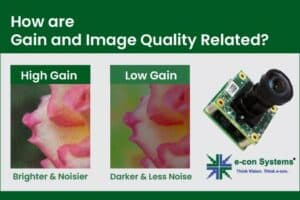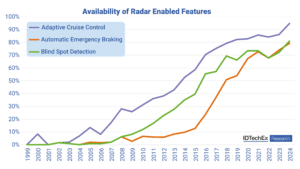Cameras and Sensors for Embedded Vision
WHILE ANALOG CAMERAS ARE STILL USED IN MANY VISION SYSTEMS, THIS SECTION FOCUSES ON DIGITAL IMAGE SENSORS
While analog cameras are still used in many vision systems, this section focuses on digital image sensors—usually either a CCD or CMOS sensor array that operates with visible light. However, this definition shouldn’t constrain the technology analysis, since many vision systems can also sense other types of energy (IR, sonar, etc.).
The camera housing has become the entire chassis for a vision system, leading to the emergence of “smart cameras” with all of the electronics integrated. By most definitions, a smart camera supports computer vision, since the camera is capable of extracting application-specific information. However, as both wired and wireless networks get faster and cheaper, there still may be reasons to transmit pixel data to a central location for storage or extra processing.
A classic example is cloud computing using the camera on a smartphone. The smartphone could be considered a “smart camera” as well, but sending data to a cloud-based computer may reduce the processing performance required on the mobile device, lowering cost, power, weight, etc. For a dedicated smart camera, some vendors have created chips that integrate all of the required features.
Cameras
Until recent times, many people would imagine a camera for computer vision as the outdoor security camera shown in this picture. There are countless vendors supplying these products, and many more supplying indoor cameras for industrial applications. Don’t forget about simple USB cameras for PCs. And don’t overlook the billion or so cameras embedded in the mobile phones of the world. These cameras’ speed and quality have risen dramatically—supporting 10+ mega-pixel sensors with sophisticated image processing hardware.
Consider, too, another important factor for cameras—the rapid adoption of 3D imaging using stereo optics, time-of-flight and structured light technologies. Trendsetting cell phones now even offer this technology, as do latest-generation game consoles. Look again at the picture of the outdoor camera and consider how much change is about to happen to computer vision markets as new camera technologies becomes pervasive.
Sensors
Charge-coupled device (CCD) sensors have some advantages over CMOS image sensors, mainly because the electronic shutter of CCDs traditionally offers better image quality with higher dynamic range and resolution. However, CMOS sensors now account for more 90% of the market, heavily influenced by camera phones and driven by the technology’s lower cost, better integration and speed.

NAMUGA to Supply 3D Camera Module for Award-winning Intel RealSense-based Product at ISC West 2025
NAMUGA to provide 3D stereo camera for next-generation smart access authentication system NAMUGA reaffirms its leadership in 3D sensing camera technology, built over more than a decade April 10, 2025 – KOSDAQ-listed company NAMUGA Co., Ltd. (190510) announced that it will supply stereo cameras, a key component of Intel’s RealSense module, for the next-generation biometric

SWIR Vision Systems in Agricultural Production
This blog post was originally published at Basler’s website. It is reprinted here with the permission of Basler. Improved produce inspection through short-wave infrared light Ensuring the quality of fruits and vegetables such as apples or potatoes is crucial to meet market standards and consumer expectations. Traditional inspection methods are often based only on visual

What is a Time-of-Flight (ToF) Camera? Basic Principle and Key Applications
This blog post was originally published at Namuga Vision Connectivity’s website. It is reprinted here with the permission of Namuga Vision Connectivity. Camera Modules Built on ToF Technology As the demand for 3D sensing technology accelerates across industries—ranging from industrial automation and robotics to smart appliances, AR/VR, and healthcare—one technology stands at the forefront: Time-of-Flight

STMicroelectronics Demonstration of Its VD55G1 BrightSense Compact, Low Power Image Sensor
Thomas Viart, Technical Product Marketing Engineer at STMicroelectronics, demonstrates the company’s latest edge AI and vision technologies and products at the 2025 CES. Specifically, Viart compares STMicroelectronics’ VD55G1 BrightSense image sensor to other standard image sensors found in the market. The VD55G1’s unique embedded features include: Smallest global shutter sensor on the market, enabling 0.6 MP,

BrainChip Extends Radar Intelligence Leadership Behind Partnership with Information Systems Laboratories
Laguna Hills, Calif. – March 31st, 2025 – BrainChip Holdings Ltd (ASX: BRN, OTCQX: BRCHF, ADR: BCHPY), the world’s first commercial producer of ultra-low power, fully digital, event-based, neuromorphic AI, today announced a partnership with Information Systems Laboratories, Inc. (ISL) to jointly promote and provide services for AI-based radar research solutions based on BrainChip’s Akida™ neural

How Are Gain and Image Quality Related?
This blog post was originally published at e-con Systems’ website. It is reprinted here with the permission of e-con Systems. Gain refers to the amplification of the signal from the image sensor to ensure that the imaging process meets defined purposes. However, trade-offs may occur in some cases. Learn about the types of gain, their

Futuristic Robotics: Robodogs and Gardening Experts
Robots mastering the weekly shop could soon free up time at the weekends. With the introduction of collaborative robots and AI agents, household chores could also become a display of the latest intelligent robotics technology. From companionship robots that engage in conversation and play board games to cars that drive themselves safely using radar and

The Rising Role of Radar in the Future of ADAS and Autonomous Driving
Availability of radar-enabled features. IDTechEx‘s report, “Automotive Radar Market 2025-2045: Robotaxis & Autonomous Cars“, predicts the automotive radar market will hit 500 million annual sales in 2041. This article takes a look at the role of radar in the future of advanced driver-assistance systems (ADAS) and autonomous driving, including market segmentation, regulatory catalysts, and regional

BrainChip Partners with RTX’s Raytheon for AFRL Radar Contract
Laguna Hills, Calif. – April 1st, 2025 – BrainChip Holdings Ltd (ASX: BRN, OTCQX: BRCHF, ADR: BCHPY), the world’s first commercial producer of ultra-low power, fully digital, event-based, neuromorphic AI, today announced that it is partnering with Raytheon Company, an RTX (NYSE: RTX) business, to service a contract for $1.8M from the Air Force Research Laboratory

NAMUGA to Exhibit at the 2025 Embedded Vision Summit
South Korea – [April 1st] – NAMUGA announced today it will exhibit at the 2025 Embedded Vision Summit, the premier event for practical, deployable computer vision and AI, for product creators who want to bring visual intelligence to products. This year’s Summit will be May 20 – 22, 2025 in Santa Clara, California. This annual

